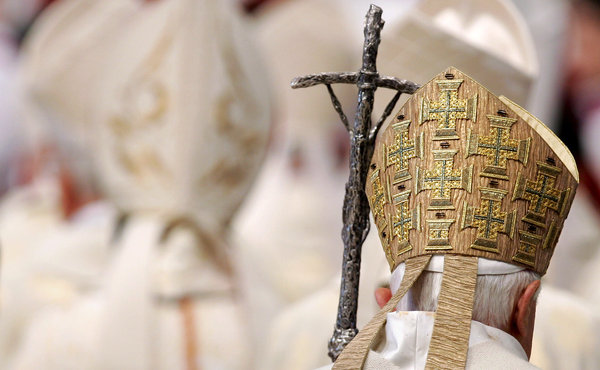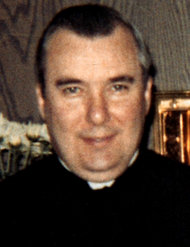A Silent Trail Leads beyond a Cover-up of Protracted Abuse
By A. O. Scott
The Rev. Lawrence C. Murphy, a Roman Catholic priest in Wisconsin who died in 1998, appears in old photographs and home movies as an energetic, round-faced man with a warm, friendly, efficient manner. Even without the sinister music that shadows these glimpses of Father Murphy’s benign, banal public activities in the ’50s and ’60s, the viewer of “Mea Maxima Culpa: Silence in the House of God,” Alex Gibney’s new documentary, will suspect that there’s something terrible lurking under the surface.
There was a time, not long ago, when a priest’s devotion to children would elicit a smile of approval rather than a shudder of suspicion and dread. The revelation early in the movie that Father Murphy, who was for many years in charge of a boarding school for the deaf, systematically molested youngsters in his care — scores if not hundreds over the years — is sickening but not especially surprising. A decade of reporting and advocacy has made stories like his distressingly familiar. “Mea Maxima Culpa” is not the first documentary to present the testimony of victims or to expose the failure of the Roman Catholic hierarchy in dealing with widespread sexual abuse by priests. Kirby Dick’s “Twist of Faith” (2004) and Amy Berg’s “Deliver Us From Evil” (2006) are both important predecessors that link intimate crimes with institutional failures. But the prolific Mr. Gibney, whose other films include “Enron: The Smartest Guys in the Room,” “Taxi to the Dark Side” and “Casino Jack and the United States of Money,” is something of a specialist in the corruptions of power. And he doggedly updates the larger story here, connecting dots that lead, in a trail of denial and cover-up, from the rural Midwest to the Vatican. His methods are a blend of solid journalism and cinematic sensationalism. The reliance on melodramatic music and lurid — though not explicit — re-enactments does not seem to me to make the movie more powerful, but rather the opposite. There is something to be said for a clear and unblinking recitation of facts, and thankfully Mr. Gibney does a lot of that. He talks with journalists who have covered the sex-abuse story (including Laurie Goodstein of The New York Times) and Catholic clergy and lay people who have pushed for transparency and accountability. (Unsurprisingly the Vatican and the American church declined his requests for interviews.) These conversations, along with archival video clips and Mr. Gibney’s own calm, angry voice-over narration, make the case that sexual abuse in the church was more than a matter of isolated misbehavior and local mismanagement. The heart of the problem, the film contends, was a conspiracy of silence that extended to — and was to some extent orchestrated in — the highest levels of the Holy See. This argument takes up much of the second half of the film, which amounts to a prosecutorial brief against Pope Benedict XVI and some of his close associates. This is important and disturbing stuff. But the heart of “Mea Maxima Culpa” — the real source of its emotional impact — lies in a remarkable series of interviews with some of the men, most now in their 60s, who endured Father Murphy’s assaults when they were children and who have worked for almost 40 years to bring his crimes to light. Their words are interpreted by well-known actors, including John Slattery, Jamey Sheridan, Chris Cooper and Ethan Hawke. The way Mr. Gibney films them, against dark backgrounds with soft, indirect light, emphasizes the expressivity of their faces and hands, and will remind hearing viewers of the richness and eloquence of American Sign Language. It is no accident that the last words signed in the film are “Deaf Power.” Much as it is a grim chronicle of violation and denial, “Mea Maxima Culpa” is also, less overtly but no less importantly, a chapter in the history of the disability rights movement. That Father Murphy’s victims were deaf gave their abuser an extra layer of protection. Some of the boys could not communicate very well with their hearing families, and Father Murphy operated in the literal certainty of their silence. These students were especially vulnerable, less because of their physical difference than because of the social marginalization that accompanied it. Their specific demand for justice as they grew older was thus also part of a larger insistence on recognition and the acquisition of a public voice. Mea Maxima Culpa Silence in the House of God Opens on Friday in Manhattan. Written and directed by Alex Gibney; director of photography, Lisa Rinzler; edited by Sloane Klevin; music by Ivor Guest and Robert Logan; produced by Mr. Gibney, Alexandra Johnes, Kristen Vaurio, Jedd Wider and Todd Wider; released by HBO Documentary Films. At the Film Forum, 209 West Houston Street, west of Avenue of the Americas, South Village. Running time: 1 hour 46 minutes. This film is not rated.
|
.
Any original material on these pages is copyright © BishopAccountability.org 2004. Reproduce freely with attribution.

